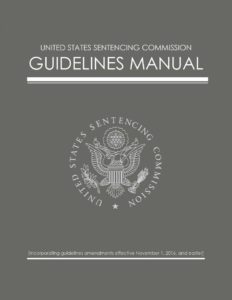Sentencing Guidelines Meaning – An Overview
If you, or a loved one, have been charged with a federal crime, are currently on trial for a federal offense, or are facing a sentencing hearing in federal criminal court; then you are probably wondering what the Federal Sentencing Guidelines mean for your case. You may even be hearing terms like “base offense level” and “offense characteristics” and have no idea what they are referring to. If you are searching for the Sentencing Guidelines meaning, you have come to the right place.
Have no fear. Like a lot of things in the law, there are terms and phrases that sound sophisticated or complex, but actually are references to very common sense concepts. Once defined, the legalese is no longer daunting. Now let's dig into the Sentencing Guidelines meaning.
Sentencing Guidelines Meaning – History of the Guidelines
When it comes to the Federal Sentencing Guidelines, a little history is in order. Back in the 1980s, Congress noticed that federal courts in one part of the country were sentencing individuals to vastly different sentences than individuals in other parts of the country for the same criminal offense. In an effort to minimize such large sentencing disparities, Congress created the United States Sentencing Commission and tasked it with creating workable guidelines that would help even out federal sentences throughout the country. The goal was to minimize disparity in sentencing between federal courts in different parts of the country.
The Guidelines became effective in 1987 and were initially binding on all federal courts. However, after the United States Supreme Court's decision in United States v. Booker, 543 U.S. 20 (2005), the Guidelines were designated as non-binding. Non-binding means that the courts should use the Guidelines to assist in sentencing decisions, but they are not required to follow them.
Currently, courts are required to consider the Guidelines, and if a court wishes to depart from the Guidelines, the court must explain what factors warranted the departure from the sentence recommended by the Guidelines. Moreover, when an appeals court reviews a federal district court's sentence, the sentence is presumed to be reasonable if it follows the Guidelines. See, e.g., Rita v. United States, 127 S. Ct. 2456 (2007). This, however, is an appellate presumption. Federal judges when sentencing defendants are prohibited from treating the Guidelines as presumptively reasonable.
Federal Sentencing Guidelines Meaning – How The Guidelines Operate

Sentencing Guidelines
The next inquiry is what the Guidelines look like in operation. The philosophy behind the Guidelines is that they should look not only at the crime, but also at the criminal in determining an appropriate punishment. Indeed, it appears fair and just that a sentence for a first-time offender would be different than a sentence for a career criminal, even if they happened to be convicted for the same exact drug crime.
Accordingly, the Guidelines look at two overarching factors – the seriousness of the offense, and the offender’s criminal history.
-
Seriousness of Offense
With regard to the seriousness of the offense, the Guidelines provide 43 “offense levels.” The designated offense level is higher if the crime is more serious. Each type of crime is given a “base offense level.” So, for example, a criminal trespass is given a base offense level of 4. Kidnapping, a more serious crime, is given a base offense level of 32.
In addition to the base offense level, each crime has a number of “specific offense characteristics.” These specific offense characteristics differentiate the levels of seriousness within a particular crime. For example, the crime of fraud has a base offense level of 7. If, however, the fraud crime in question involved $6,000 in loss, then the court should apply a 2-level increase to 9. If the fraud involved $50,000 in loss, the court should apply a 6-level increase. In sum, a $6,000 fraud crime will have an offense level of 9, whereas a $50,000 fraud crime will have an offense level of 13.
Finally, with regard to the seriousness of the offense, the court may make “adjustments” to the offense level based on factors such as the offender’s role in the offense. For example, a minimal participant in an offense will have the offense level decreased by 4 levels. Yet, if the offender knew the victim was particularly vulnerable, then the offense level is increased by 2 levels. A court may also take into account the offender’s acceptance of responsibility and decrease the offense level accordingly.
-
Criminal History
When it comes to criminal history, the Guidelines assign each defendant to one of six “criminal history categories.” Category I is for first-time offenders and those with minimal criminal histories, whereas Category VI includes offenders with the most significant criminal histories.
-
Determining the Sentence Based on Offense and Criminal History
Once the court has determined the final offense level (by taking the base offense level, including the specific offense characteristics, and making any necessary adjustments), and decided upon the appropriate criminal history for a defendant, the court then consults the Guideline’s Sentencing Table. That table is simply a grid where the Criminal History Category is on the horizontal axis and the Offense Level is on the vertical axis. The box where the Offense Level meets the Criminal History Category provides the sentencing range according to the Guidelines. Thus, a person with a Criminal History Category of I and an Offense Level of 20 (e.g., a robbery perpetrator with no criminal history) would have a recommended sentence of 33 to 41 months (or about 3 years or so) in prison.
Finally, once the court gets the Guideline’s recommended sentencing range, the court still has discretion to “depart” from that range based on unusual aggravating or mitigating circumstances. Those sentencing departures must, however, be explained by the court.
To conclude, this brief primer on the Federal Sentencing Guidelines meaning is just a short overview. If you need further information, you should consult an attorney with federal sentencing experience.
Brandon Sample, Esq. practices in federal courts throughout the country. Brandon Sample is a top-notch sentencing attorney and advocate. Those facing a sentencing hearing, or who wish to challenge a sentence already imposed, should call Brandon for a free initial consultation. Brandon can be reached at 802-444-HELP.
Recommended for you
Ex Parte Communications By Judge With Jury Required Reversal Of Convictions
At Martin Bradley III’s trial for racketeering, mail fraud, wire fraud, and money laundering, the district court had two ex parte communications with the jury. Bradley’s defense lawyers did not become aware of notes until after his appeal. Bradley filed a 2255 motion arguing, in addition to other things, that the court had violated Rule…
Drug Treatment And Vocational Training Improper Sentencing Considerations
Christopher Thornton moved for a downward variance at sentencing arguing, among other things, that “in-prison treatment during the proposed thirty-eight months would help mitigate any potential risk he posed to the community.” The district court denied the motion, but in doing so said that Thornton had “mental-health issues, and he needs drug treatment” and that…
Amendment 782 Motion Reconsideration
Reinaldo Rivera moved for 18 U.S.C. § 3582(c)(2) relief based on Amendment 782 to the Guidelines, commonly known as “drugs minus 2.” The district court granted the motion and reduced his sentence to 420 months from LIFE. But in doing so, the district court believed Rivera’s mandatory minimum was 30 years for his CCE conviction.…




